Quick Summary: This blog explores how businesses can calculate and improve the ROI of AI apps with practical, data-driven strategies. The content explains key AI ROI metrics, real-world AI use cases, and methods to control AI app development cost effectively. Readers will learn how the right AI development services and expert partners turn technology into measurable business growth. The guide simplifies complex concepts so business leaders can make smarter AI investment decisions and achieve consistent returns.
When generative AI gained momentum in 2022, companies rushed to bring it into their core operations. Leaders wanted faster insights, lower costs, and smarter products.
The excitement was real, but the results often told another story. Many soon realized that the ROI of AI apps wasn’t matching expectations.
A 2023 IBM Institute for Business Value report revealed that enterprise AI projects achieved only a 5.9% return even after a 10% capital investment. (Source: IBM)
That imbalance forced many organizations to pause and question their approach. Some adopted AI too quickly, driven by urgency instead of direction.
Others treated it as a quick fix rather than a growth strategy. Real ROI comes from focus, data quality, and strong execution. This guide explains how to calculate and improve the ROI of AI applications across industries while aligning with emerging AI trends so each investment creates measurable business impact.
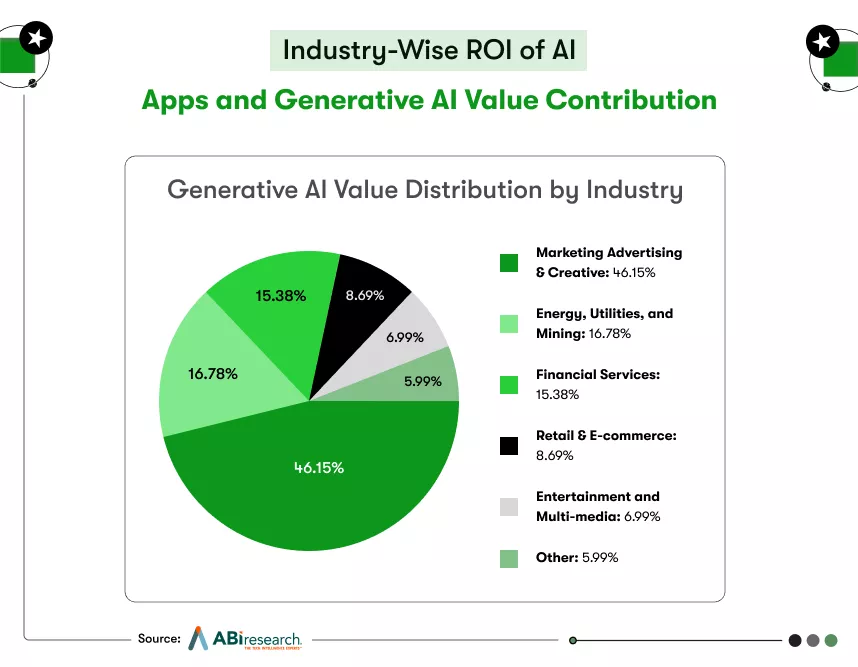
What Does the ROI of AI Apps Actually Mean?
The ROI of AI apps defines how much measurable business value artificial intelligence creates compared to the investment required to develop and deploy it. It covers every dimension that impacts growth, from revenue generation and cost optimization to productivity gains and smarter decision-making.
The value of an AI system evolves continuously because each model learns from new data, user behavior, and real-world outcomes. As the quality of training data improves, predictions become sharper, and business results strengthen. This ongoing learning creates a compounding return effect that traditional software cannot replicate.
The ROI of AI applications across industries is best evaluated through four core dimensions that together present a complete picture of value:
- Financial impact: measurable revenue increase, lower costs, and improved profit margins.
- Operational efficiency: faster workflows, optimized resource use, and reduced errors.
- Customer experience: stronger engagement, personalized interactions, and higher retention.
- Strategic outcomes: data-backed forecasting, quicker innovation, and improved market competitiveness.
Each ROI component contributes differently depending on an organization’s data maturity, infrastructure readiness, and business goals. Measuring them collectively across relevant AI use cases allows leadership teams to see how AI performance grows across departments.
Many organizations misread AI performance because they measure only cost savings. Broader evaluation highlights real value such as faster decisions, lower risks, and improved accuracy. A logistics company can achieve better delivery rates, while a bank reduces fraud incidents.
These measurable outcomes define AI ROI metrics that align technology results with financial goals. When this framework connects with strategy, businesses learn how to calculate ROI for AI app projects and achieve consistent long-term growth.
The Complete Method to Calculate ROI of AI Apps for Real Results
The ROI of AI apps is calculated by comparing the measurable gains from artificial intelligence with the total investment required to create and maintain it. In simple terms, ROI equals the value gained minus the total cost, divided by the total cost. Unlike traditional projects, AI performance grows with time as models learn and improve, which makes calculation slightly more complex.
To get an accurate assessment, leaders must go beyond surface numbers and evaluate both tangible and intangible results.
Tangible results include direct cost reduction, process automation, and revenue growth. Intangible results include improved decision accuracy, faster response times, and better customer experiences. Together, they create a holistic view of business impact and help shape future AI business ideas that deliver measurable returns.
Key Components of AI ROI Calculation
1. Initial Investment:
Covers data collection, infrastructure setup, development, and model training. These early expenses form the baseline for all ROI evaluations and determine how efficiently future improvements deliver value.
2. Operational and Maintenance Costs:
Include retraining models, updating infrastructure, and technical support. Regular maintenance ensures reliable performance and prevents costly downtime or declining accuracy.
3. Business Gains:
Represent measurable results like higher revenue, reduced errors, and faster workflows. Tracking these outcomes over time shows how artificial intelligence contributes to financial growth.
4. Strategic Impact:
Captures long-term benefits such as accurate forecasting, smarter decisions, and faster innovation. These advantages strengthen competitiveness and shape sustainable growth.
Each of these components directly contributes to AI profitability, and together they define real performance beyond initial implementation.
Example of an AI ROI Formula
| ROI Component | Example Metric | How to Measure |
| Financial gain | Revenue growth, cost reduction | Compare pre- and post-deployment data |
| Efficiency | Time saved, output increase | Track workflow and productivity metrics |
| Accuracy | Error reduction, prediction precision | Evaluate historical vs. current results |
| Customer experience | Engagement, retention | Analyze surveys and usage data |
The ROI calculation framework delivers both quantitative and qualitative insights that define success. The resulting insights help leaders identify which AI functions produce the most measurable returns and where optimization is required.
When organizations apply this structured approach, they gain a clear, data-backed understanding of how artificial intelligence influences overall business performance. This clarity enables teams to plan future projects confidently and gain executive support for continued investment.
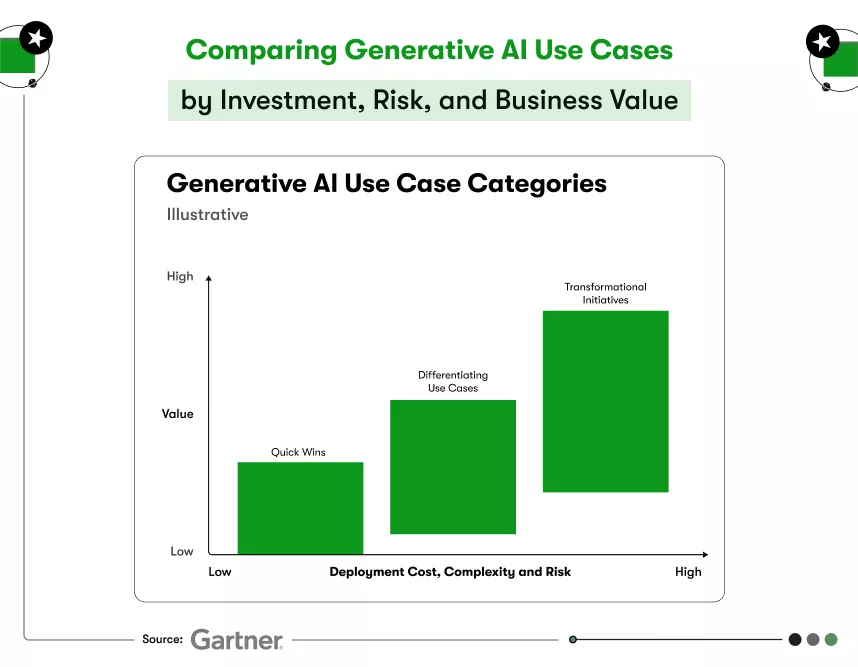
Traditional App ROI vs. AI App ROI: What’s the Real Difference?
The ROI of AI apps and traditional software applications differ in how they create and sustain value. Traditional software typically delivers immediate, measurable benefits once deployed, while artificial intelligence continues to generate value over time.
AI systems learn from data, refine outputs, and adapt to new business conditions, making their performance curve more dynamic than predictable.
The ROI of AI applications across industries depends on continuous data improvement, model accuracy, and strategic alignment. Traditional applications operate with fixed logic that produces consistent but static results.
In contrast, AI-driven systems increase efficiency, accuracy, and automation as data quality grows. This evolution, strengthened through continuous AI app development, creates a long-term compounding effect where the benefits multiply with every model iteration.
Detailed Comparison of Traditional App ROI and AI App ROI
The difference between traditional app ROI and the ROI of AI apps lies in how value is created, measured, and sustained. Traditional apps offer static, short-term returns, while AI systems produce dynamic, compounding gains through continuous learning and data improvement.
| Aspect | Traditional App ROI | AI App ROI |
| Value Pattern | Provides measurable value soon after deployment but remains static until updated. | Expands value gradually as algorithms learn from new data and user behavior. |
| Data Dependency | Operates on predefined logic and limited data inputs. | Relies heavily on data quality, training frequency, and diversity of information. |
| Scalability | Grows through manual feature additions that increase costs linearly. | Scales exponentially as more data drives better automation and accuracy. |
| Measurement Method | Measured once post-deployment through cost-benefit analysis. | Requires ongoing tracking through adaptive performance metrics. |
| Performance Longevity | Performance decreases without upgrades or redesigns. | Performance improves continuously through retraining and feedback cycles. |
| Predictability of Outcomes | Produces stable and easily forecasted results. | Generates evolving results that improve with each learning cycle. |
| Maintenance Focus | Involves bug fixes and minor updates. | Involves regular retraining, monitoring, and validation of models. |
| Innovation Scope | Limited to existing features and functionalities. | Encourages continuous innovation using data-driven insights. |
| Risk Exposure | Low because behavior remains predefined. | Higher during early stages when model accuracy depends on training quality. |
| Return Timeline | Offers fast but limited short-term returns. | Delivers gradual, long-term returns that strengthen as data maturity increases. |
Implications for Business Leaders and Why Understanding ROI Differences Matters
Traditional applications deliver quick, predictable ROI that plateaus without reinvestment. Artificial intelligence, however, continues to generate value as models learn and adapt. Businesses that plan around continuous improvement and measurable outcomes achieve scalable, lasting growth.
Leaders tracking AI ROI metrics must view measurement as an ongoing process, not a one-time task. Continuous optimization strengthens revenue, efficiency, and accuracy.
Companies that use professional AI development services and understand how to calculate ROI for AI app initiatives can forecast results confidently and build sustainable competitive advantage.
Comparing the two ROI approaches reveals that traditional apps deliver stability, while AI-driven systems create expanding value that grows stronger with data maturity. Recognizing this difference allows companies to plan smarter and sustain growth over time.
Leaders who know the difference between traditional and AI ROI can read results more accurately and make smarter decisions that turn artificial intelligence investments into measurable business growth.
Proven Strategies to Improve the ROI of AI Apps for Your Business
Increasing the ROI of AI apps starts with a practical strategy that connects technology decisions with measurable business outcomes.
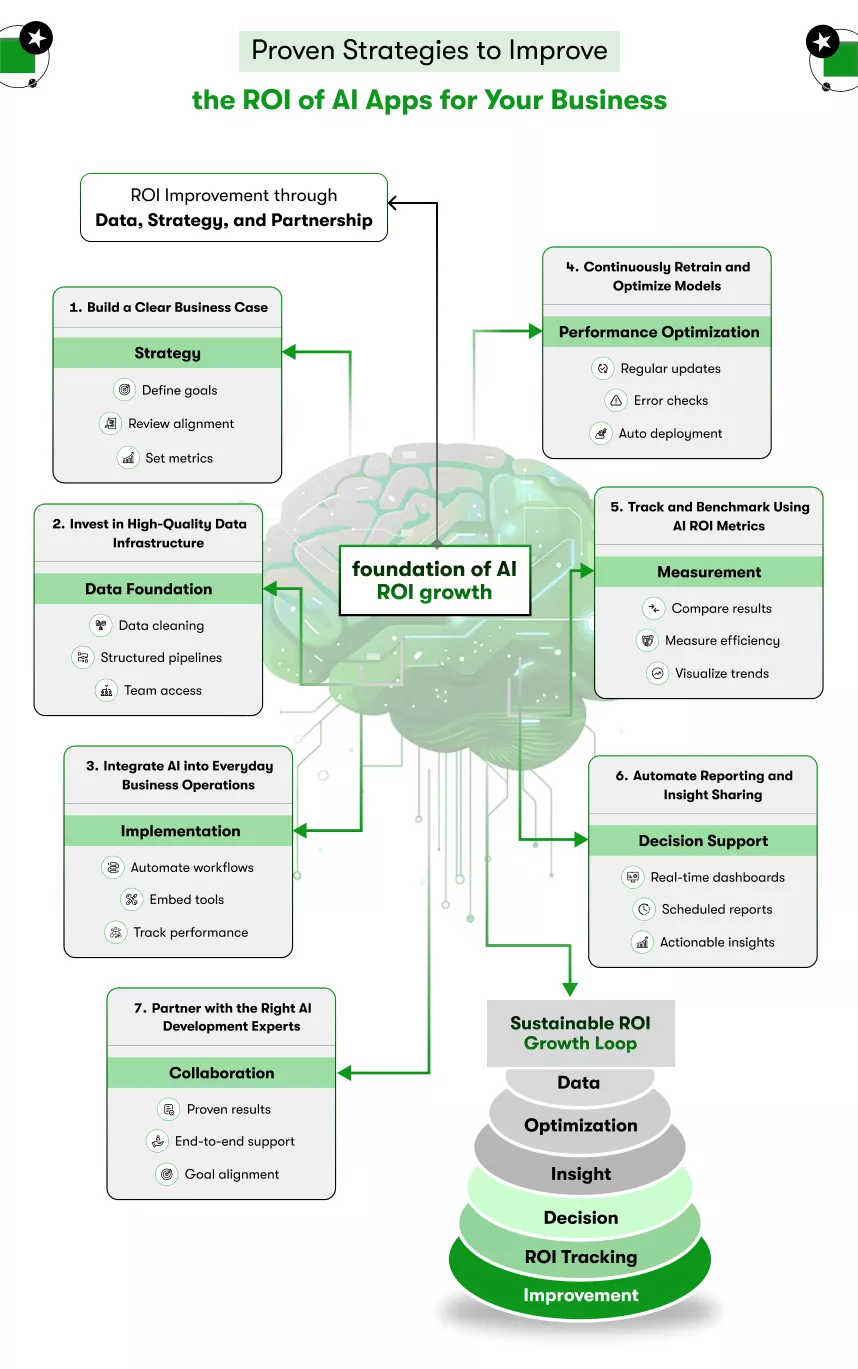
True ROI improvement comes from precise data management, continuous optimization, and leadership commitment to turning AI into an ongoing value-creation engine.
1. Build a Clear Business Case
A strong AI initiative begins with a focused objective and measurable success criteria. Leaders must define how artificial intelligence will improve revenue, reduce cost, or increase efficiency before implementation begins.
- Set quantifiable goals such as cost reduction or customer acquisition targets.
- Define metrics that directly connect to financial or operational outcomes.
- Revisit objectives regularly to ensure alignment with changing priorities.
2. Invest in High-Quality Data Infrastructure
Data forms the foundation of every AI outcome. Reliable, organized, and comprehensive data sources help improve accuracy and model performance. Companies that prioritize data preparation achieve faster validation and stronger confidence in their predictions.
- Create structured pipelines for continuous data collection and cleaning.
- Remove outdated or duplicate records to maintain consistency.
- Secure data accessibility for cross-departmental collaboration.
3. Integrate AI Into Everyday Business Operations
AI delivers measurable returns only when it becomes part of regular workflows. Embedding AI tools into customer service, logistics, finance, or marketing improves speed, accuracy, and decision-making.
- Identify high-impact processes where AI can replace repetitive tasks.
- Encourage teams to adopt AI insights for daily decision-making.
- Connect outputs from AI systems with performance dashboards to monitor gains.
4. Continuously Retrain and Optimize Models
AI performance declines without regular improvement. Updating models with fresh, relevant data ensures the system adapts to real-world changes and keeps outcomes accurate.
- Schedule periodic retraining cycles to refresh model accuracy.
- Monitor errors and anomalies to identify areas needing recalibration.
- Use automation pipelines to deploy updates faster across departments.
5. Track and Benchmark Using AI ROI Metrics
AI ROI measurement extends beyond financial savings. Evaluating efficiency, speed, and accuracy together provides a more realistic performance view. Tracking these dimensions over time highlights where returns are rising or stagnating.
- Measure KPIs like process time reduction and decision accuracy.
- Compare pre- and post-AI results for transparency.
- Use dashboards to visualize progress for leadership review.
6. Automate Reporting and Insight Sharing
Real ROI improvement depends on timely insights. Automated reporting allows decision-makers to review AI performance quickly and act before small issues grow into costly inefficiencies.
- Implement dashboards that refresh in real time.
- Send scheduled reports to project owners and management.
- Translate complex data into clear, actionable business recommendations.
7. Partner With the Right AI Development Experts
Selecting a skilled partner determines whether an AI project succeeds or struggles. A capable team ensures accurate development, reliable infrastructure, and continuous optimization for maximum returns.
- Choose experts with proven results in enterprise-scale AI deployment.
- Expect end-to-end support including strategy, development, and maintenance.
- Prioritize partners who align technology with your specific business goals.
Companies that implement these strategies build a measurable growth path driven by artificial intelligence. Each action increases performance efficiency and drives tangible improvement in ROI across departments.
Sustainable success depends on data, strategy, and partnership. Businesses that refine these three pillars realize consistent growth, manage AI app development cost effectively, and maximize the long-term ROI of AI apps.
Why Partnering With Experts Maximizes the ROI of AI Apps
Maximizing the ROI of AI apps requires experience, technical depth, and a structured approach that most in-house teams cannot build overnight. Working with expert partners accelerates performance, reduces risk, and ensures every investment converts into measurable business outcomes.
1. Strategic Planning and Feasibility Analysis
Before any code is written, expert teams conduct a deep assessment of business objectives and operational challenges. They identify areas where AI can generate measurable improvements and ensure the goals align with organizational priorities. This planning phase avoids guesswork and builds a clear roadmap for investment and returns.
- Experts define use cases that connect AI directly to revenue or efficiency gains.
- They evaluate infrastructure readiness to confirm scalability and security.
- Feasibility studies highlight the right balance between innovation and practicality.
- Timelines and budgets are created to maintain realistic ROI expectations.
2. Custom AI Development and Seamless Integration
Building AI systems that work perfectly within existing operations is crucial for achieving fast results. Skilled partners design solutions that integrate with enterprise workflows and software infrastructure without disruption. This integration ensures teams use AI effectively across departments and experience tangible productivity improvements.
- Developers align every AI feature with core business processes.
- Integration reduces duplication and simplifies data sharing across systems.
- Tailored solutions ensure faster user adoption within existing teams.
- Maintenance becomes easier because compatibility issues are addressed early.
3. Continuous Optimization and Model Tuning
AI models require consistent monitoring and improvement to stay relevant. Expert teams perform retraining cycles, track accuracy, and adapt algorithms to new data patterns. This process keeps predictions sharp and aligns outcomes with real-time business dynamics.
- Regular model audits help identify performance drifts early.
- Retraining schedules maintain accuracy across changing datasets.
- Optimization enhances forecasting and decision-making reliability.
- Feedback loops transform operational data into ongoing learning inputs.
4. Transparent Performance Monitoring
Reliable partners provide full visibility into how AI investments perform over time. They build dashboards that translate technical outcomes into simple financial insights for leadership teams. This transparency allows organizations to see what works, make adjustments, and measure ROI growth confidently.
- Dashboards display performance metrics and trend comparisons.
- Reports link model results with specific cost or efficiency gains.
- Real-time alerts notify stakeholders about deviations or anomalies.
- Consistent reporting supports data-driven business reviews.
5. Faster Implementation and Cost Efficiency
AI initiatives often stall due to long development cycles or high costs. Experienced partners bring proven frameworks and accelerators that cut both time and expenses. This approach ensures faster deployment without sacrificing performance or accuracy.
- Standardized frameworks eliminate repetitive development work.
- Early testing avoids expensive post-launch fixes.
- Scalable solutions minimize future upgrade costs.
- Time-to-value improves, allowing earlier measurement of business gains.
6. Access to Multidisciplinary Expertise
Effective AI deployment demands collaboration between engineers, data scientists, and business strategists. Expert partners bring all these disciplines together to create a balanced, outcome-focused implementation. This diversity ensures every AI decision serves a measurable business purpose.
- Data scientists refine models to fit real-world conditions.
- Engineers build secure and scalable infrastructure.
- Analysts connect insights to business objectives.
- Cross-functional teams guarantee consistent execution quality.
7. Scalable Support and Long-Term Partnership
AI success depends on continuous evolution, not one-time implementation. Expert partners provide ongoing monitoring, retraining, and improvement programs to keep ROI growing. Their proactive approach ensures performance remains strong as business conditions and technologies change.
- Post-launch support includes periodic audits and updates.
- Scalability plans prepare systems for higher data volumes.
- Continuous consulting aligns AI progress with business goals.
- Long-term collaboration turns innovation into measurable growth.
Partnering with the right experts transforms artificial intelligence from an isolated experiment into a measurable growth engine. Their structured, ongoing involvement guarantees accuracy, adaptability, and sustained profitability.
Organizations that collaborate with specialized AI consultants achieve faster deployment, lower costs, and stronger outcomes, unlocking the full potential and measurable value of the ROI of AI apps.
If you want to learn how to build intelligent chat solutions, explore our AI chatbot development services to understand the complete process and create impactful customer experiences.

How to Choose the Right AI Development Partner to Maximize ROI
Selecting the right partner determines whether the ROI of AI apps becomes a success story or a sunk cost. The right development company brings proven expertise, reliable processes, and measurable results that connect technology to real business value.
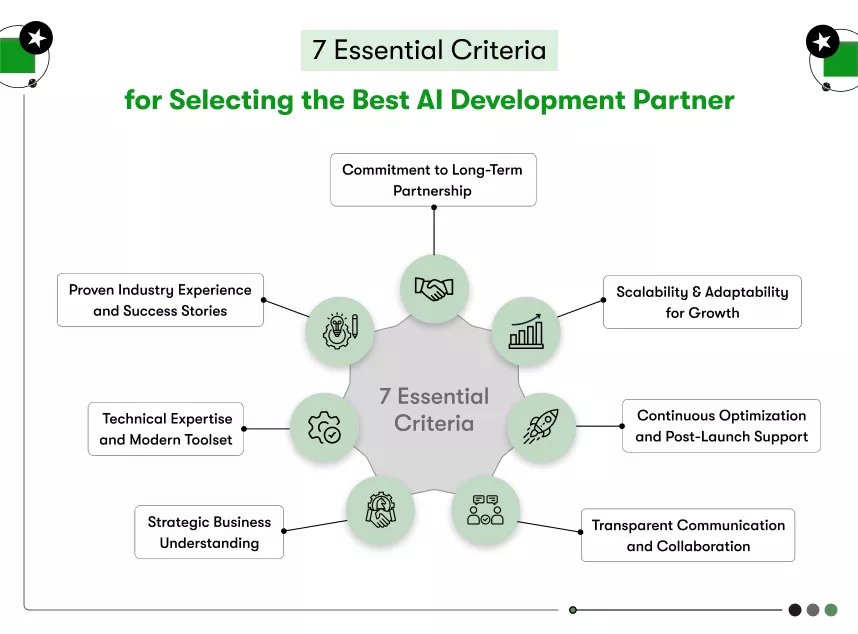
A strategic partner focuses on performance, scalability, and post-launch optimization to ensure continuous ROI growth.
1. Proven Industry Experience and Success Stories
Experience defines reliability. A capable AI partner has already delivered measurable outcomes across multiple industries and understands how to apply technology to different business models. Reviewing portfolios and case studies reveals how effectively the company translates AI potential into business success.
- Review project case studies to assess past ROI outcomes.
- Check industry relevance to confirm domain understanding.
- Validate client references that prove transparency and credibility.
- Ensure the company’s experience matches your business goals.
2. Technical Expertise and Modern Toolset
Deep technical skill reduces risk and shortens timelines. Skilled teams select the right frameworks, architect secure pipelines, and build scalable services. Cloud proficiency matters for resilience, monitoring, and cost control. Tool choice must fit current and future needs.
- Validate hands-on work with TensorFlow, PyTorch, and managed AI services.
- Confirm knowledge of MLOps, CI/CD, and secure data engineering.
- Check experience with model observability and drift detection.
- Ensure technology choices support the ROI of AI applications across industries.
3. Strategic Business Understanding
AI success depends on aligning technical goals with business direction. A strong partner takes time to understand your industry, customers, and financial targets before designing solutions. This alignment helps convert technology investments into measurable business growth.
- Discuss your short-term and long-term business objectives with clarity.
- Ensure the partner links AI features with profitability and efficiency goals.
- Look for consulting capabilities, not just technical development.
- Evaluate how they translate business metrics into actionable technical plans.
4. Transparent Communication and Collaboration
Open communication builds trust and eliminates project delays. A dependable partner shares progress reports, risk updates, and upcoming milestones clearly with stakeholders. Collaboration ensures that every team, including technical and leadership groups, remains aligned on shared outcomes.
- Expect regular updates on timelines, performance, and ROI progress.
- Request dashboards that show real-time project and data insights.
- Choose teams that encourage feedback throughout development.
- Confirm accessibility of key personnel for faster problem resolution.
5. Continuous Optimization and Post-Launch Support
The most successful AI partnerships extend beyond deployment. Continuous optimization ensures that AI systems remain relevant, accurate, and efficient as business environments evolve. Regular monitoring and retraining protect the investment and strengthen ROI growth over time.
- Ask about ongoing support, maintenance, and performance updates.
- Evaluate their retraining cycles and data management processes.
- Expect proactive recommendations for improving model accuracy.
- Review reports that show measurable improvement in outcomes.
6. Scalability and Adaptability for Growth
Systems must grow with data, traffic, and use cases. Architecture should support new features without major rewrites. Cost curves should remain predictable at a higher scale. Flexible design protects reliability and budgets.
- Validate horizontal scaling for services, storage, and inference.
- Confirm rollout safety with canary releases and rollback plans.
- Check multi-region readiness for uptime and compliance.
- Make sure leaders can explain how to calculate ROI for AI app expansions as usage increases.
7. Commitment to Long-Term Partnership
True ROI comes from relationships built on trust and collaboration. A long-term partner helps refine strategies, optimize models, and evolve systems as your business grows. This continuous engagement transforms AI from a single project into a sustainable growth engine.
- Review their track record for multi-phase or long-term collaborations.
- Confirm that they offer consulting and innovation support beyond launch.
- Expect periodic performance assessments and future planning sessions.
- Choose a partner who grows with your organization, not just your project.
Selecting a qualified AI development partner ensures every investment produces measurable business value. With the right collaboration, companies achieve faster deployment, continuous optimization, and sustained ROI performance.
Leaders who apply these criteria and choose to hire AI developers with proven expertise select teams that deliver measurable value, sustain accuracy, and strengthen the ROI of AI apps quarter after quarter.
Why Kody Technolab Is the Right Partner to Maximize the ROI of AI Apps
The true ROI of AI apps depends on how well technology connects with real business value. Kody Technolab Limited helps global enterprises design and implement AI systems that deliver measurable results. Each solution is engineered to enhance revenue, improve accuracy, and reduce operational waste, ensuring every investment generates sustainable financial returns.
1. Proven Expertise Across Industries
Kody Technolab has helped companies in fintech, logistics, healthcare, and retail improve their ROI of AI applications across industries. Every engagement begins with a deep understanding of business goals, followed by clear data mapping and strategy design. Our experienced engineers and analysts ensure that every AI feature contributes to measurable profit and growth.
- Delivered performance-driven AI solutions that improved client ROI by over 30%.
- Enhanced operational accuracy using predictive analytics models.
- Implemented AI workflows that shortened project delivery time by 25%.
2. End-to-End AI Development and Integration
Our development process covers the complete journey from consultation and data preparation to model integration and optimization. This approach helps companies build reliable AI ecosystems that support existing operations. Each solution is customized to the organization’s size, workflow, and target outcomes to maximize the ROI of AI apps.
- Integrate AI seamlessly within legacy and modern software.
- Design scalable models that grow with business demands.
- Deliver AI applications that simplify decision-making for every department.
3. Performance Tracking and Measurable Results
Businesses often struggle to measure the success of their AI initiatives. Kody Technolab solves this challenge by building real-time analytics dashboards and clear reporting systems. Our teams monitor the complete performance cycle to ensure full visibility into AI ROI metrics and business impact.
- Create custom dashboards for financial and operational reporting.
- Track accuracy, processing time, and cost reduction metrics.
- Provide ongoing insights to refine performance and boost ROI.
4. Collaborative and Scalable Partnership
Our approach to collaboration ensures transparency, flexibility, and shared ownership. We work as an extension of your internal team, aligning development goals with business priorities. This partnership enables organizations to scale confidently and calculate the ROI of AI applications across industries with consistency.
- Maintain consistent communication through project reviews and feedback sessions.
- Scale AI capabilities as data, traffic, and business requirements evolve.
- Provide strategic consulting that supports long-term ROI improvement.
5. Continuous Optimization for Long-Term Growth
AI solutions must evolve with changing business environments. Kody Technolab focuses on ongoing model optimization and retraining to ensure lasting value. Our continuous improvement programs teach businesses how to calculate ROI for AI app projects and monitor them effectively.
- Conduct frequent evaluations to maintain accuracy and reliability.
- Provide proactive updates for performance enhancement.
- Offer predictive insights that uncover new growth opportunities.
Kody Technolab builds AI solutions that grow with your business and deliver measurable outcomes across every department. Every project is designed to strengthen revenue, efficiency, and the ROI of AI apps from day one.
If your organization is ready to turn data and technology into measurable business profit, connect with Kody Technolab today and start realizing the real ROI of AI applications across industries.
Conclusion
The measurable value of artificial intelligence depends on strategy, not hype. Businesses that focus on the ROI of AI apps achieve faster decisions, stronger margins, and smarter operations. Each improvement compounds when guided by the right partner and reliable data.
Across global markets, the ROI of AI applications across industries continues to prove that planned execution beats experimental spending.
Kody Technolab, a trusted generative AI development company, helps organizations design, deploy, and optimize AI systems that deliver real business impact. Our team blends strategy and technology to ensure predictable outcomes.
Partner with us to learn how to calculate ROI for AI app projects and turn your artificial intelligence investment into measurable, long-term growth.

Frequently Asked Questions
1. What is the ROI of AI apps and why does it matter?
The ROI of AI apps measures how much value a business gains compared to what it spends on AI implementation. It matters because it helps companies understand whether their investment in AI applications leads to measurable outcomes like revenue growth, cost savings, or productivity improvement.
2. How can businesses calculate the ROI of AI apps?
Businesses can calculate ROI using this formula:
ROI = (Net Benefit from AI – Total AI Cost) ÷ Total AI Cost × 100.
Net benefit includes cost reductions, efficiency gains, and revenue increases. Accurate calculation also depends on tracking AI ROI metrics such as automation savings, time reduction, and accuracy improvement.
3. What factors influence the ROI of AI applications across industries?
ROI depends on data quality, AI strategy, technology stack, and user adoption. For example, companies that use reliable AI development services and structured data pipelines achieve higher returns compared to those that focus only on implementation speed or cost.
4. How can organizations improve the ROI of AI apps?
Improving ROI requires continuous optimization and integration into core business workflows. Regular model retraining, automation of repetitive processes, and clear performance tracking all enhance ROI. Partnering with a trusted generative AI development company also ensures better accuracy, scalability, and measurable outcomes.
5. What is a realistic timeframe to see ROI from AI app development?
Most organizations start seeing measurable ROI within 6 to 12 months after deployment, depending on project complexity, data maturity, and user adoption. Continuous monitoring and retraining shorten this timeframe and improve long-term sustainability.
6. How do AI ROI metrics differ from traditional software ROI?
Traditional software ROI focuses on license cost, efficiency, and time savings. AI ROI metrics, however, also measure data accuracy, predictive success, and learning improvement over time, and factors that compound value as the model matures.
7. How do AI development partners help increase ROI?
An experienced partner aligns business objectives with AI solutions. They ensure efficient deployment, cost control, and long-term support. Businesses that hire AI developers from reliable partners often achieve faster time-to-value and sustained ROI growth.
8. How much does AI app development cost and what affects it?
The AI app development cost varies based on project scope, data volume, model complexity, and integration needs. Custom AI apps with advanced automation or prediction features usually cost more but deliver higher ROI through operational efficiency and improved accuracy.
9. Can AI chatbot development services improve customer ROI?
Yes. Businesses using AI chatbot development services can reduce support costs, improve response speed, and enhance user satisfaction. Chatbots handle repetitive interactions 24/7, freeing human agents for complex tasks and directly improving service ROI.
10. What are some examples of AI use cases with high ROI potential?
High-ROI AI use cases include predictive maintenance in logistics, fraud detection in fintech, patient outcome prediction in healthcare, and personalized marketing in retail. These applications turn data into real business decisions that drive measurable financial returns.


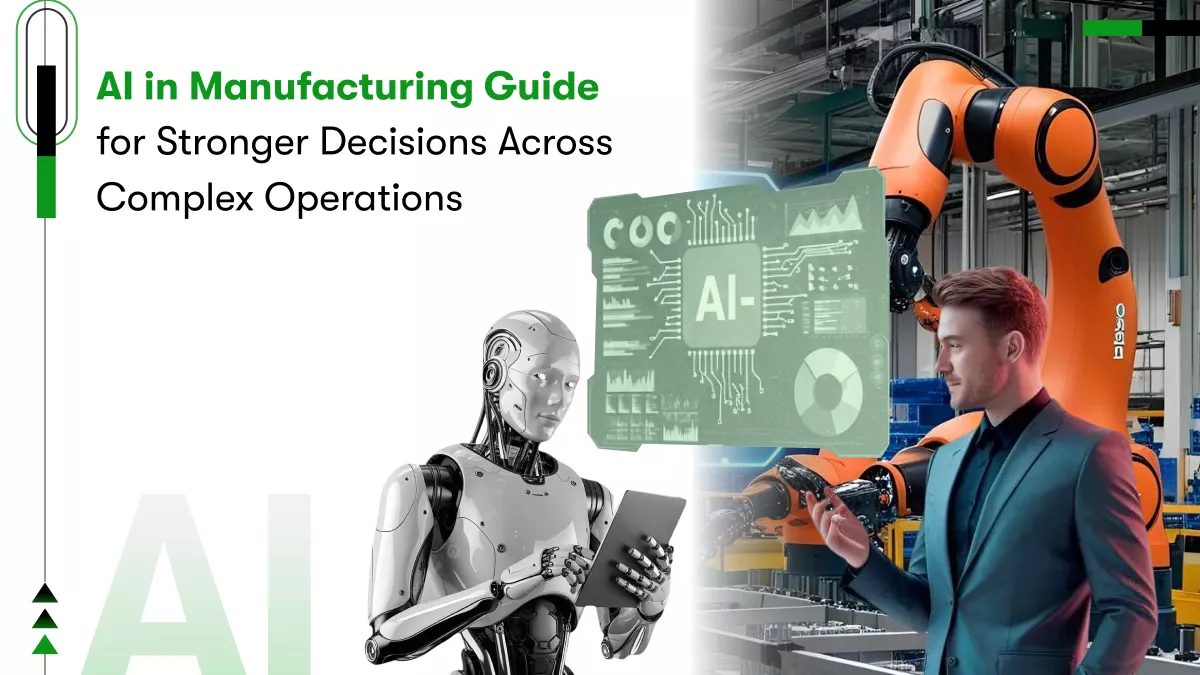

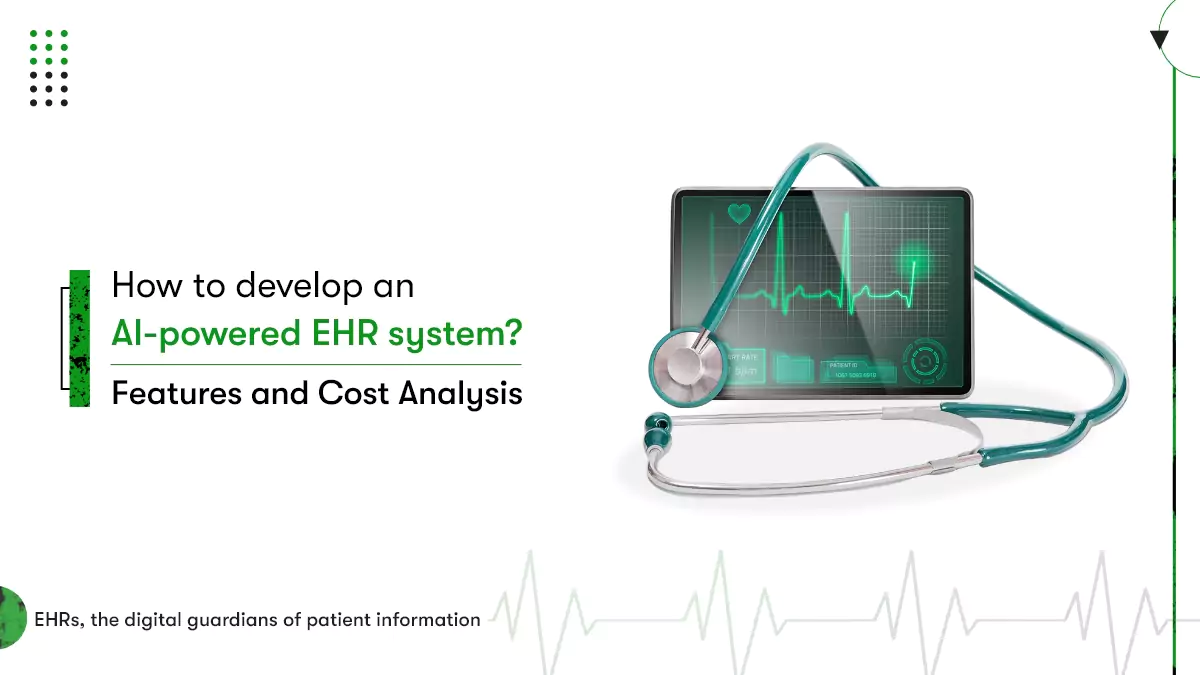








 Contact Information
Contact Information